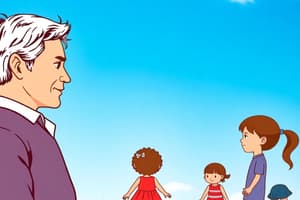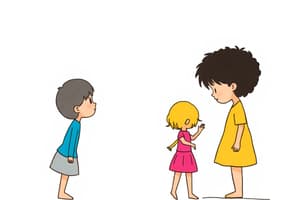Podcast
Questions and Answers
Which of the following best describes the focus of Erikson's theory of psychosocial development?
Which of the following best describes the focus of Erikson's theory of psychosocial development?
- The impact of societal expectations on gender identity formation.
- The resolution of psychosocial crises at different stages of life to develop specific virtues. (correct)
- The influence of early childhood experiences on the development of defense mechanisms.
- The development of cognitive abilities through distinct stages.
According to Erikson's stages of psychosocial development, what is the primary conflict during adolescence (ages 11-20)?
According to Erikson's stages of psychosocial development, what is the primary conflict during adolescence (ages 11-20)?
- Generativity vs. Stagnation
- Identity vs. Identity confusion (correct)
- Intimacy vs. Isolation
- Industry vs. Inferiority
Which of Erikson's psychosocial stages involves forming deep, committed relationships with others?
Which of Erikson's psychosocial stages involves forming deep, committed relationships with others?
- Generativity vs. Stagnation
- Autonomy vs. Shame and Doubt
- Intimacy vs. Isolation (correct)
- Industry vs. Inferiority
How does successful resolution of Erikson's first stage of psychosocial development (Trust vs. Mistrust) primarily influence an infant's later development?
How does successful resolution of Erikson's first stage of psychosocial development (Trust vs. Mistrust) primarily influence an infant's later development?
A toddler who constantly says 'No!' and tries to do things independently, like dressing themselves, is most likely in which of Erikson's stages?
A toddler who constantly says 'No!' and tries to do things independently, like dressing themselves, is most likely in which of Erikson's stages?
What is the central theme of Erikson's stage of 'Generativity vs. Stagnation'?
What is the central theme of Erikson's stage of 'Generativity vs. Stagnation'?
According to the content provided, what does 'temperament' primarily refer to in the context of emotional development?
According to the content provided, what does 'temperament' primarily refer to in the context of emotional development?
A child who is described as 'slow-to-warm-up' typically exhibits which of the following characteristics?
A child who is described as 'slow-to-warm-up' typically exhibits which of the following characteristics?
Which statement accurately contrasts 'easy' and 'difficult' temperaments in children?
Which statement accurately contrasts 'easy' and 'difficult' temperaments in children?
According to the information provided, what is 'attachment' defined as?
According to the information provided, what is 'attachment' defined as?
In Mary Ainsworth's Strange Situation experiment, a child classified as 'securely attached' is most likely to demonstrate which behavior when their caregiver returns after a brief separation?
In Mary Ainsworth's Strange Situation experiment, a child classified as 'securely attached' is most likely to demonstrate which behavior when their caregiver returns after a brief separation?
Which attachment style is characterized by inconsistent behavior from the infant such as confusion and contradictory actions upon the caregiver's return?
Which attachment style is characterized by inconsistent behavior from the infant such as confusion and contradictory actions upon the caregiver's return?
What does the concept of 'Goodness of Fit' refer to in the context of emotional development?
What does the concept of 'Goodness of Fit' refer to in the context of emotional development?
How does a child-rearing environment that demonstrates 'goodness of fit' influence a child's development?
How does a child-rearing environment that demonstrates 'goodness of fit' influence a child's development?
What is a key distinction between social smiles and reflexive smiles in infants?
What is a key distinction between social smiles and reflexive smiles in infants?
Around what age do infants typically begin to react to meaningful events with emotional expressions?
Around what age do infants typically begin to react to meaningful events with emotional expressions?
What does the 'rouge test' primarily assess in infants and toddlers?
What does the 'rouge test' primarily assess in infants and toddlers?
During the preschool years, how do family members primarily influence a child's emotional development?
During the preschool years, how do family members primarily influence a child's emotional development?
How do 'emotion-coaching' parents typically respond to their children's emotional expressions?
How do 'emotion-coaching' parents typically respond to their children's emotional expressions?
Which factor has been shown to correlate with lower self-esteem during adolescence?
Which factor has been shown to correlate with lower self-esteem during adolescence?
According to Sternberg's Triangular Theory of Love, what three components make up consummate love?
According to Sternberg's Triangular Theory of Love, what three components make up consummate love?
In Sternberg's Triangular Theory of Love, 'infatuated love' is characterized primarily by which component?
In Sternberg's Triangular Theory of Love, 'infatuated love' is characterized primarily by which component?
According to Sternberg's Triangular Theory of Love, which type of love is defined by commitment and intimacy, but lacks passion?
According to Sternberg's Triangular Theory of Love, which type of love is defined by commitment and intimacy, but lacks passion?
Which form of Sternberg's Triangular Theory of Love is defined by passion and commitment, but lacking intimacy?
Which form of Sternberg's Triangular Theory of Love is defined by passion and commitment, but lacking intimacy?
Flashcards
Erikson's Theory
Erikson's Theory
Erikson's has a theory with 8 stages of psychosocial development.
Erikson's Stage 1
Erikson's Stage 1
Stage 1 (0-1) is centered around Trust vs. Mistrust. Infants develop trust when needs are met.
Erikson's Stage 2
Erikson's Stage 2
Stage 2 (1-3) is centered around Autonomy vs. Shame & Doubt. Toddlers strive for independence.
Erikson's Stage 3
Erikson's Stage 3
Signup and view all the flashcards
Erikson's Stage 4
Erikson's Stage 4
Signup and view all the flashcards
Erikson's Stage 5
Erikson's Stage 5
Signup and view all the flashcards
Erikson's Stage 6
Erikson's Stage 6
Signup and view all the flashcards
Erikson's Stage 7
Erikson's Stage 7
Signup and view all the flashcards
Erikson's Stage 8
Erikson's Stage 8
Signup and view all the flashcards
Temperament
Temperament
Signup and view all the flashcards
Reactivity
Reactivity
Signup and view all the flashcards
Self-regulation
Self-regulation
Signup and view all the flashcards
Easy Child
Easy Child
Signup and view all the flashcards
Difficult Child
Difficult Child
Signup and view all the flashcards
Slow-to-Warm-Up Child
Slow-to-Warm-Up Child
Signup and view all the flashcards
Attachment
Attachment
Signup and view all the flashcards
Strange Situation
Strange Situation
Signup and view all the flashcards
Secure Attachment
Secure Attachment
Signup and view all the flashcards
Avoidant Attachment
Avoidant Attachment
Signup and view all the flashcards
Disorganized/Disoriented
Disorganized/Disoriented
Signup and view all the flashcards
Goodness of Fit
Goodness of Fit
Signup and view all the flashcards
Infancy & Toddlerhood
Infancy & Toddlerhood
Signup and view all the flashcards
Primary Emotions
Primary Emotions
Signup and view all the flashcards
Self-Awareness
Self-Awareness
Signup and view all the flashcards
Preschool Age
Preschool Age
Signup and view all the flashcards
Study Notes
- Emotional development covers Erikson's theory, temperament, attachment, lifespan emotional changes, and love.
Erikson's Theory of Psychosocial Development
- Operates within the psychosocial/socioemotional domain.
- Consists of 8 stages.
- Each stage presents a psychosocial crisis.
Erikson's Stages
- 0-1 year: Trust vs. Mistrust, with Hope as the virtue.
- 1-3 years: Autonomy vs. Shame & Doubt, with Will as the virtue.
- 3-6 years: Initiative vs. Guilt, with Purpose as the virtue.
- 6-11 years: Industry vs. Inferiority, with Competence as the virtue.
- 11-20 years: Identity vs. Identity confusion, with Fidelity as the virtue.
- 20-40 years: Intimacy vs. Isolation, with Love as the virtue.
- 40+ years: Generativity vs. Stagnation, with Care as the virtue.
Stage 1: Trust vs. Mistrust (0-1 year)
- Centers on hope and the relationship with a primary parent.
- Resolved when the baby is lovingly and sympathetically cared for.
- Resolution leads to confident, adventurous infants.
Stage 2: Autonomy vs. Shame & Doubt (1-3 years)
- Centers on will and relationships with parents.
- Negativism, or doing the opposite of what others want, emerges.
- Infant uses phrases like "No!", "Mine!", and "Do it myself!".
- Resolution occurs when parents use suitable guidance and choices.
- Resolution creates independent infants.
Stage 3: Initiative vs. Guilt (3-6 years)
- Centers on purpose and relationships with family.
- Focuses on a child's newfound freedom versus guilt when getting in trouble.
Stage 4: Industry vs. Inferiority (6-11 years)
- Centers on competence and relationships with school.
- Children develop a sense of competence with useful skills and tasks.
- A child either discovers their own capabilities or has little confidence in their ability to do things well.
Stage 5: Identity vs. Identity/Role Confusion (11-20 years)
- Centers on fidelity and relationships with peers.
- Explores concepts of occupation, values, and sexual identity.
- Involves developing/constructing an identity or becoming directionless because society limits choices.
Stage 6: Intimacy vs. Isolation (20-40 years)
- Centers on love and relationships with friends, partners.
- Focuses on a young person's feelings and thoughts about making a permanent commitment to a partner.
- Involves the attainment of intimacy or being alone.
Stage 7: Generativity vs. Stagnation (40-65 years)
- Centers on care and relationships with workmates and family.
- Reaching out to others to guide the next generation through commitment to family, community, and society and continuity of children, ideas, products, & arts.
- Can involve becoming self-centered and self-indulgent, being more worried about what can be gotten than what can be given.
Stage 8: Ego-Integrity vs. Despair (65+ years)
- Centers on wisdom and relationships with people.
- Reflecting back on life, with concern about happiness or regrets.
Temperament
- Early-appearing, stable individual differences in reactivity and self-regulation.
- Reactivity refers to the intensity of emotional arousal, attention, and motor activity.
- Self-regulation refers to strategies to modify reactivity.
Temperament Classifications
- Easy child: 40% establish regular routines, have a cheerful mood, and adapt easily to new experiences.
- Difficult child: 10% have irregular routines, are moody, and react negatively and intensely to new experiences.
- Slow-to-warm-up child: 15% have mild and low-key reactions to routine, have a negative mood, and adjust slowly to new experiences.
- 35% have a blend of temperaments.
Attachment
- A reciprocal, positive, enduring emotional tie between an infant and caregiver, such as in Harlow’s Attachment Study.
Attachment Styles
- Secure (66%): Use the parent as a secure base, cry when the parent leaves, and seek them when they return.
- Avoidant (20%): Unresponsive to the parent when around and show no response when the parent leaves or returns.
- Resistant (10-15%): Show they do not want the parent to leave and are both distressed when the parent leaves and angry when they return.
- Disorganized/Disoriented (5-10%): Show the greatest insecurity and display confused, contradictory behaviors.
"Goodness of Fit"
- Temperament and environment together produce a favorable outcome.
- A child-rearing environment that recognizes a child's temperament encourages adaptive functioning.
Emotional Development in Infancy & Toddlerhood
- Emotions serve to communicate needs and facilitate exploration.
- 0-6 months: Infants react to internal processes and stimulation, smiling reflexively.
- 6+ months: Infants react to meaningful events, smiling socially.
- Primary emotions/universal facial expressions include joy, happiness, surprise, sadness, anger, fear, and disgust.
- Self-awareness develops around 18-24 months, assessed through the Rouge Test.
- Involves social referencing, stranger anxiety, and separation anxiety.
Emotional Development in Preschool Age
- Increased understanding of emotions and emotional self-regulation.
- Children begin to exhibit prosocial behavior through the family modeling.
- Aggression may surface via instrumental aggression, overt aggression, and relational aggression/social bullying.
Emotional Development in Middle Childhood
- Self-esteem is based on adult judgments and conditional self-esteem.
- Emotional self-regulation develops.
- Culture's display rules dictate how people express emotions in different social contexts.
- Parenting and emotional development involve emotion-coaching and emotion-dismissing parents.
Emotional Development in Adolescence
- Adolescent rebellion is not typical.
- Self-esteem is lower for girls, racial minorities, and those with a low socioeconomic status (SES).
Emotional Development in Adulthood
- Attachment styles in infancy may influence future relationships.
Sternberg's Triangular Theory of Love
- Passion: Physical attraction.
- Intimacy: Emotional connection.
- Commitment: Cognitive decision to maintain the relationship.
Studying That Suits You
Use AI to generate personalized quizzes and flashcards to suit your learning preferences.




